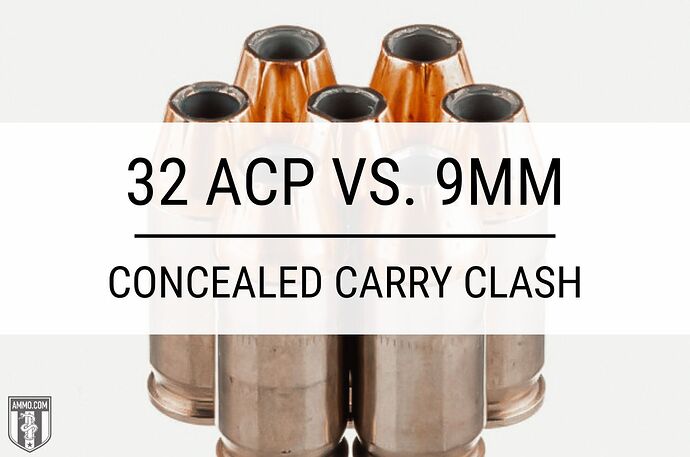When looking for a new concealed carry cartridge, you’ve likely considered the 380 ACP, 9mm, and 45 ACP. However, John Moses Browning created a legendary cartridge– the 32 ACP –that might be worth considering.
Throughout this article, we’ll compare the 32 ACP vs. 9mm in critical categories most important to shooters and concealed carriers. Recoil, accuracy, stopping power, and self-defense capabilities are a few sections we will discuss in detail to help us determine a winner.
Once you finish reading, you can confidently choose the best cartridge for your situation.
Let’s go!
32 ACP vs. 9mm
The 9mm is also called the 9x19mm Parabellum, 9x19mm NATO, 9mm NATO, or 9mm Luger. In Europe, the .32 ACP is called the 7.65mm Browning.
Both centerfire handgun cartridges are over 100 years old, so a less experienced shooter might think they’re obsolete. In fact, the 9mm remains a favorite of many concealed-carry enthusiasts and law enforcement officers. Meanwhile, the 32 ACP struggles to stay relevant.
The 9mm and 32 Auto are chambered in semi-automatic pistols. The 32 ACP was designed for pocket pistols, like the Beretta Tomcat and KelTec P32, whereas the 9mm was designed for full-size pistols. In recent decades, carbines and revolvers have been designed around the 9mm cartridge.
Below, you’ll discover the technical specs that make these cartridges unique. Afterward we’ll begin our comparison to help you decide which personal defense cartridge is right for you!
Technical Specs: 9mm vs. 32 ACP
The 32 ACP cartridge is noticeably smaller than the 9mm, as it fires a smaller diameter bullet, has less case capacity, and is shorter overall.
The bullet diameter of a 32 ACP round is 0.3125 inches, whereas the 9mm is 0.355 inches. The case capacity of the 9mm is 13.3 grains; the 32 ACP, only 9.25 grains. The 9mm’s higher case capacity and chamber pressure enable its heavier bullet to attain a higher muzzle energy – and strike with greater kinetic energy because of it.
While these cartridges have some significant differences, they were designed for similar tasks. Let’s see how these numbers translate into real-world situations.
Recoil
Recoil is a critical consideration when purchasing a new handgun, as a round with heavy recoil will be more challenging to control and slow your follow-up shots. The potential for recoil flinching (anticipation) is also an issue for cartridges with powerful kick.
Felt recoil will differ from shooter to shooter and is often dependent on firearm choice, stance, and your chosen ammo. However, free recoil is a more objective measure of how hard a cartridge hits based on firearm weight, muzzle velocity, powder charge, and bullet weight.
Both handgun rounds are known for having low recoil. We’ll compare two loads for reference.
For the 9mm, we’ll fire Winchester white box 115 grain full metal jacket (FMJ) with a muzzle velocity of 1,190 fps out of a Glock 45 weighing 2 pounds. Under these circumstances, the 9mm has a free recoil of 4 ft-lbs, which isn’t much.
For the 32 ACP, we’ll fire Fiocchi Range Dynamics 73 grain FMJ with a muzzle velocity of 1,000 fps out of a North American Arms Guardian weighing 0.8 pounds. Under these conditions, the 32 ACP has a free recoil of 1.7 ft-lbs – less than half that of the 9mm.
The 32 ACP wins this section because it has less recoil. Its very low recoil makes handling the firearm easier for most shooters.
Accuracy: 9x19mm Parabellum vs. .32 Auto
Cartridge accuracy depends on several factors, such as bullet design, firearm, shooter, and shooting conditions. That means this comparison can never be truly apples to apples.
However, we can still help you decide which one you might be more accurate with: a 9mm or 32 ACP pistol!
A “mouse gun” chambered for 32 ACP is an excellent option for recoil-sensitive shooters. When I was a kid, my grandpa had a 25 ACP pistol we would use for target shooting and firing into ballistic gel for fun. It didn’t have much recoil, and I was reasonably accurate with it. The same can be said for the 32 ACP. Its low recoil will probably allow you to be more accurate.
The advantage of the 9mm is its longer barrel. In some instances, this isn’t much of an advantage (compact pistols often used for concealed carry), but it is in others (full-size pistols and carbines). A longer barrel will help you be more accurate when firing a gun because it gives the propellant longer to burn, increasing the velocity of the round an flattening its trajectory. I carry a 9mm Smith & Wesson Shield and have accurate shot placement at the range.
This section is a draw, as some shooters will enjoy the lower recoil benefits of the 32 ACP, while others will take advantage of the longer barrels of 9mm pistols. I recommend testing several high-quality factory loads to see what your firearm handles the best.
Continue reading 32 ACP vs. 9mm: Concealed Carry Clash on Ammo.com


